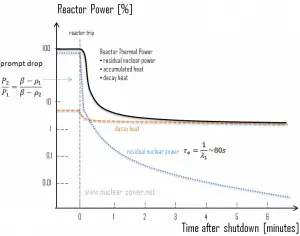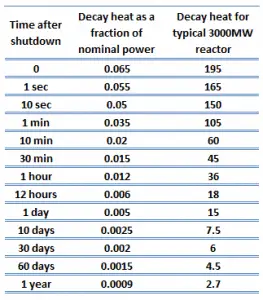
Spent nuclear fuel, also called the used nuclear fuel, is a nuclear fuel that has been irradiated in a nuclear reactor (usually at a nuclear power plant or an experimental reactor), and a fresh fuel must replace that due to its insufficient reactivity. Spent nuclear fuel is characterized by fuel burnup, a measure of how much energy is extracted from nuclear fuel, and a measure of fuel depletion. Due to fuel depletion and fission fragments buildup, spent nuclear fuel is no longer useful in sustaining a nuclear reaction in an ordinary thermal reactor and must be replaced by fresh fuel. It may have considerably different isotopic constituents depending on its point along the nuclear fuel cycle.
It must be noted that irradiated fuel is due to the presence of a high amount of radioactive fission fragments and transuranic elements that are very hot and very radioactive. Reactor operators must manage the heat and radioactivity that remains in the “spent fuel” after it’s taken out of the reactor. In nuclear power plants, spent nuclear fuel is stored underwater in the spent fuel pool on the plant, and plant personnel moves the spent fuel underwater from the reactor to the pool. Over time, as the spent fuel is stored in the pool, it becomes cooler as the radioactivity decays away. After several years (> 5 years), decay heat decreases under specified limits so that spent fuel may be reprocessed or interim storage.
Spent Fuel Decay Heat
 Fission essentially ceases when a reactor is shut down, but decay energy is still being produced. The energy produced after shutdown is referred to as decay heat. The amount of decay heat production after shutdown is directly influenced by the reactor’s power history (fission products accumulation) before shutdown and by the level of fuel burnup (actinides accumulation – especially in the case of spent fuel handling). A reactor operated at full power for 10 days before shutdown has much higher decay heat generation than a reactor operated at low power for the same period. On the other hand, when the reactor changes its power from 50% to 100% of full power, the decay heat to neutron power ratio drops to roughly half its previous level. It builds up slowly as the fission product inventory adjusts to the new power.
Fission essentially ceases when a reactor is shut down, but decay energy is still being produced. The energy produced after shutdown is referred to as decay heat. The amount of decay heat production after shutdown is directly influenced by the reactor’s power history (fission products accumulation) before shutdown and by the level of fuel burnup (actinides accumulation – especially in the case of spent fuel handling). A reactor operated at full power for 10 days before shutdown has much higher decay heat generation than a reactor operated at low power for the same period. On the other hand, when the reactor changes its power from 50% to 100% of full power, the decay heat to neutron power ratio drops to roughly half its previous level. It builds up slowly as the fission product inventory adjusts to the new power.
 The decay heat produced after a reactor shutdown from full power is initially equivalent to about 6 to 7% of the rated thermal power. Since radioactive decay is a random process at the level of single atoms, it is governed by the radioactive decay law. Note that irradiated nuclear fuel contains many different isotopes that contribute to decay heat, all subject to the radioactive decay law. Therefore a model describing decay heat must consider decay heat to be a sum of exponential functions with different decay constants and initial contribution to the heat rate. Fission fragments with a short half-life are much more radioactive (at the time of production) and contribute significantly to decay heat but will obviously lose their share rapidly. On the other hand, fission fragments and transuranic elements with a long half-life are less radioactive (at the time of production) and produce less decay heat but will obviously lose their share more slowly. This decay heat generation rate diminishes to about 1% approximately one hour after shutdown. As was written, the decay comes from the beta and gamma decay of fission products and transuranic elements (+ alpha decay).
The decay heat produced after a reactor shutdown from full power is initially equivalent to about 6 to 7% of the rated thermal power. Since radioactive decay is a random process at the level of single atoms, it is governed by the radioactive decay law. Note that irradiated nuclear fuel contains many different isotopes that contribute to decay heat, all subject to the radioactive decay law. Therefore a model describing decay heat must consider decay heat to be a sum of exponential functions with different decay constants and initial contribution to the heat rate. Fission fragments with a short half-life are much more radioactive (at the time of production) and contribute significantly to decay heat but will obviously lose their share rapidly. On the other hand, fission fragments and transuranic elements with a long half-life are less radioactive (at the time of production) and produce less decay heat but will obviously lose their share more slowly. This decay heat generation rate diminishes to about 1% approximately one hour after shutdown. As was written, the decay comes from the beta and gamma decay of fission products and transuranic elements (+ alpha decay).
See also: Decay Heat